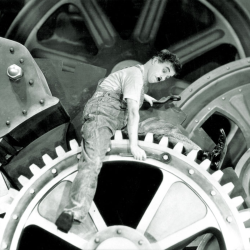According to the Sapir–Whorf hypothesis, our language influences how we think and experience the world. That’s easy to imagine. Certainly our symbolism of mathematics influences how we calculate. Can you imagine doing moderately complex math with Roman numerals or without zero or negative numbers? But recently I was reminded that technological media also influences our perception of reality, and I have a Hackaday post to thank for it.
The post in question was about color TV. When I was a kid, most people had black and white TVs, although there were color sets. Even if you had a color set, many shows and movies were in black and white. Back then, many people still shot black and white film in their cameras, too, for many reasons. To make matters worse, I grew up in a small town, reading books from the local library that were ten or twenty years behind the times.
At some point, I read a statistic that said that most people dream in black and white. You may find this surprising, as I’ll bet you dream in color. It turns out, how people dream may have changed over the years and still and motion photography may be the reason.
The Post
In the post, I posed a question I’ve thought about many times: Did people dream in black and white before the advent of photography? It was kind of an off-hand remark to open the post, but many people reacted to it in the comments. They seemed surprised that I would ask that because, of course, everyone dreams in color.
I asked a few people I knew who also seemed very surprised that I would assume anyone ever dreams in color. But I was sure I had been told that sometime in the past. Time to hit the Internet and find out if that was incorrect or a false memory or something else. Turns out, it was indeed something else.
The Science

A scientific paper from 2008 held the answer. It turns out that science started asking questions like this in the early 1900s. Up through the 1940s, people overwhelmingly reported dreaming in black and white, at least most of the time. Color dreams were in the minority, although not unheard of.
Then something changed. Studies that occurred in the 1960s and later, show exactly the opposite. People almost always dream in color and rarely in black and white. Of course, that correlates well with the rise of color photos, movies, and television. What’s more is, while there is no scientific evidence gathering about earlier times, there is a suspicious lack of, for example, a Shakespeare quote about “The gray world of slumber…” or anything else that would hint that the writer was dreaming in black and white.
Interpretation
Judging from the paper, it seems clear that most people agree that color media played a role in this surprising finding. What they can’t agree on is why. It does seem unlikely that your dreams really change based on your media consumption. But it is possible that your recollection changes. This is particularly true since the way researchers acquired data changed over that time period, too. But even if the data doesn’t show that you dreamed in black and white, it did show that you remembered dreaming in black and white.
For that matter, it isn’t clear that anyone understands how you experience dreams visually, anyway. It isn’t like the back of your eyelids are little movie screens. You don’t actually see anything in a dream, you only remember seeing it.
The Question
If something as simple as black-and-white movies and TV can change how we perceive dreams, you have to wonder how much tech is changing our reality experience in other ways. Do we live differently because we have cell phones? Or the Internet? Will virtual reality alter our dream lives? It would be interesting to fast-forward a century and see what historians say about our time and how strangely we perceive reality today.




















